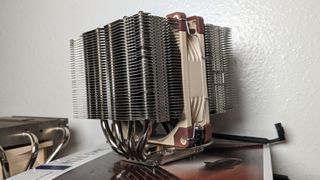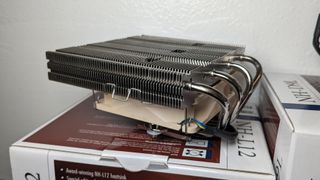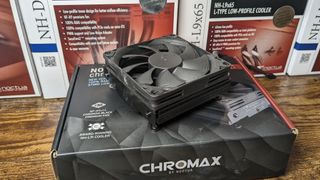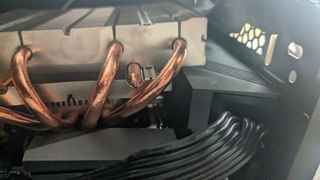Noctua SFF Cooler Roundup: Testing Small Coolers Against Intel’s Core i9-13900K
How much (or how little) heat can SFF coolers handle?

For many enthusiasts, Austrian company Noctua represents the pinnacle of PC Cooling. Known for top-tier cooling designs like the NH-D15S, as well as its distinctive brown fans, Noctua has earned and maintained a loyal following since its founding in 2005. With its focus on quiet fans and capable, often high-end, coolers, the company has often landed on our list of best CPU coolers.
But instead of focusing on massive metal tower coolers like the NH-P1, today we’ll be taking a look at five of Noctua’s small form factor (SFF) CPU coolers. You wouldn’t always want to pair these smaller coolers with top-end CPUs, we’ll be testing them with Intel’s Core i9-13900K to see just how much – or how little – they can handle in today’s world of thermally demanding processors.
Overview of the Coolers
As is obvious to anyone who has built a compact PC, SFF cases can have many constraints – and come in many sizes. As such, all the coolers we’re looking at here were designed for different scenarios. When building an SFF computer system, you’ll need to be aware of limitations caused by the case you’re using, the heatsinks of the motherboard you’re using, and/or the height of your RAM. As I found out during testing, what may work great in one SFF case may be fully incompatible in another.
NH-L9x65

The NH-L9x65 is the second-smallest cooler we’ll be testing for this story. It’s similar to many other compact top-down air coolers but features a thicker heatsink and four heatpipes, instead of the standard two for coolers of this type. It stays within the Intel recommended 95x95mm footprint, which means that you’ll have full compatibility on any motherboard no matter how compact it’s components are.
NH-D9L

In many ways, the NH-D9L is a miniature version of Noctua’s NH-D15S. The NH-D9L operates like a standard desktop cooler, with a single fan in the middle of the cooler pushing the heat away from the reduced-size dual-tower heatsinks. It is fully RAM and PCI-e compatible with all Intel ITX motherboards, and most AMD-based motherboards.
NH-L12S

The NH-L12S was designed for cases with height limitations, with a total height of only 70mm when the slim fan is installed underneath the heatsink fins. Its fan can be installed either underneath or below the heatsink. When the fan is installed at the top of the heatsink, it’s fully compatible with tall RAM, up to 48mm in height.
NH-L12 Ghost S1 Edition

The NH-L12 Ghost S1 Edition is a revised version of the previous cooler, that has been revised to fit smaller spaces, specially designed for the Louqe Ghost S1 computer case. The changes include a reduced height compared to the NH-L12S; it’s only 66mm tall instead of 70mm. The length of the heatpipes has also been shortened, and they are on a narrower angle. Finally, it has a smaller 92mm fan instead of a 120mm fan on the standard NH-L12S.
Stay On the Cutting Edge: Get the Tom's Hardware Newsletter
Get Tom's Hardware's best news and in-depth reviews, straight to your inbox.
NH-L9i-17XX

The L9i-17xx is the most “basic” of the coolers we’re testing today. Its compact heatsink has only two heatpipes and a total height of just 37mm, making it ideal for the slimmest and most space-constrained environments. As such, it offers 100% RAM and PCI-e compatibility on all motherboards. We tested the Chromax black model, but if you prefer Noctua’s traditional brown and beige, the L9i-17xx is available in those colors, as well.
Testing Methodology and SFF Constraints
Modern high-end CPUs, whether Intel or AMD, are difficult to cool in intensive workloads. In the past, reaching 95C+ on a desktop CPU might have been a cause for concern – but with today’s processors, it’s considered normal operation. Similar behavior has been present in laptops for years due to cooling limitations in tight spaces.
That said, SFF coolers aren’t designed to handle the full power of CPUs like Intel’s i9-13900K or Ryzen 7950X, and when using one the CPU will likely reach TJMax (the maximum temperature before throttling occurs) in many workloads. So if I were to apply the same standards I use for standard cooler testing to SFF coolers, most of them would simply fail.
These compact coolers are designed to provide adequate cooling power in space-constrained environments, and as such many SFF builders prefer to use lower-power CPUs like AMD’s Ryzen 5 7600 or Intel’s i5-12400. Still, for today’s testing, we’ll be pairing them with Intel’s i9-13900K to see just how much – or little – these coolers can handle. But we’ll also be testing with different power limits, which will tell us a lot about how these coolers will perform with lower-end CPUs.
We’ll be evaluating these coolers based on their performance in 3 metrics:
1. Maximum noise levels
2. Maximum cooling performance
3. Noise normalized results with a 95W Power Limit.
These coolers will be tested in Silverstone’s SUGO 14 SFF case, which I chose for its versatility and features, including a 5.25-inch optical drive and full-size PSU support.

| CPU | Intel Core i9-13900K | Row 0 - Cell 2 |
| Motherboard | Gigabyte B660i Aorus Pro DDR4 | Row 1 - Cell 2 |
| Case | Silverstone SUGO 14 | Row 2 - Cell 2 |
| PSU | Silverstone HELA 1300R Platinum | Row 3 - Cell 2 |
Originally I had planned to include comparison results here from Noctua’s competitors, including BeQuiet’s Shadow Rock LP and Iceberg Thermal’s IceFLOE T95. But I ran into compatibility issues which prevented this.
The B660i Aorus Pro motherboard has tall heatsinks for both the motherboard’s VRMs and for the NVMe SSD slot. As a result, the heatpipes of BeQuiet’s Shadow Rock LP were blocked by the heatsinks of the motherboard, no matter which direction I attempted to install it.

I also attempted to install Iceberg Thermal’s IceFLOE T95, but the mounting bars alone pushed against the DDR4 memory sticks, making it incompatible. Installing the cooler further would have pushed the RAM modules even more, a recipe for instability at best.
After encountering these issues and finding it strange that I didn’t run into similar problems with Noctua’s coolers, I reached out to a Noctua representative. He pointed out that the company works closely with motherboard manufacturers as well as Intel and AMD to ensure broad compatibility, while also noting that the expansive range of the company’s compact coolers lets builders choose the best option for their specific system.
Noctua also maintains a Compatibility Centre database that lets you check whether a given cooler is designed to work with specific CPUs, motherboards, cases, and RAM.

Albert Thomas is a contributor for Tom’s Hardware, primarily covering CPU cooling reviews.
Most Popular

